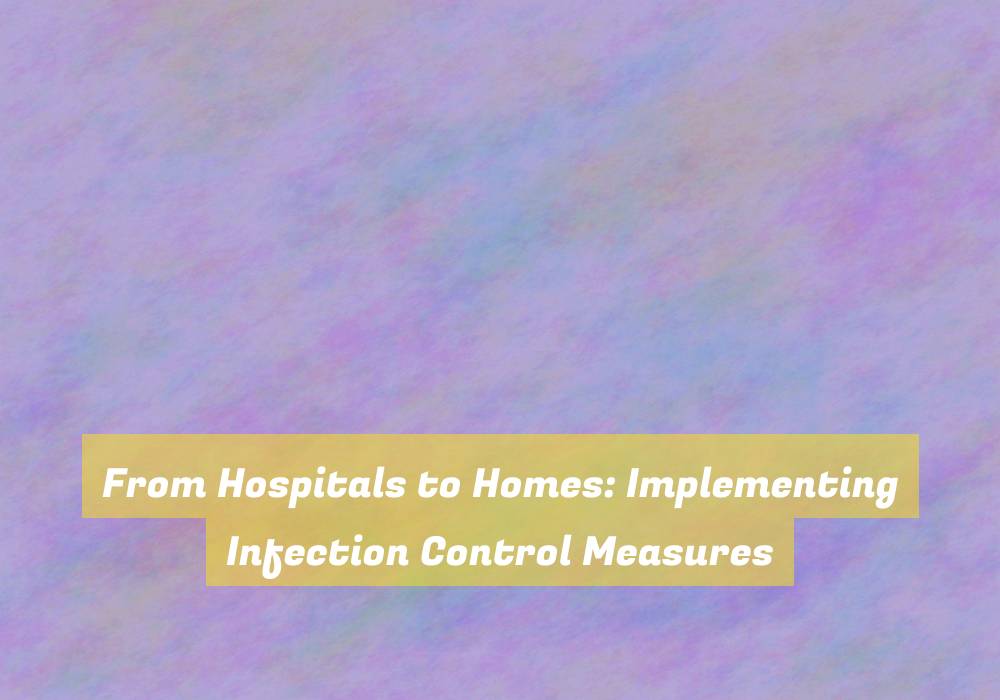From Hospitals to Homes: Implementing Infection Control Measures
When it comes to transitioning from the controlled environment of a hospital to the more relaxed setting of a home, there are certain measures that should be put in place to ensure the safety and well-being of everyone involved.
As you consider the importance of maintaining a clean and safe environment, itG??s crucial to understand the best practices for implementing infection control. Healthcare professionals play a pivotal role in guiding and supporting these efforts, but there are also key steps that individuals and families can take to contribute to this important goal.
By exploring the nuances of infection control in different environments, you can gain valuable insights into how to protect yourself and those around you.
Understanding Infection Control
To effectively implement infection control measures, itG??s essential to understand the principles and practices that govern the prevention and spread of infections. By comprehending the modes of transmission and the factors that contribute to the spread of infections, you can proactively take steps to minimize the risk of contamination.
Understanding the principles of infection control involves recognizing the importance of hand hygiene, proper sanitation, and the use of personal protective equipment. It also means being aware of how infections can be transmitted through direct contact, droplets, airborne particles, or contaminated surfaces.
Furthermore, grasping the practices that govern infection control empowers you to implement targeted measures to prevent the spread of infections. This includes adhering to standard precautions, such as wearing gloves and masks when necessary, and adopting transmission-based precautions when dealing with individuals known or suspected to be infected.
Additionally, understanding the significance of environmental cleaning and disinfection in breaking the chain of infection is crucial for creating a safe and hygienic environment.
Implementing Best Practices
You can enhance infection control measures by consistently implementing best practices in your daily routines.
One of the most effective best practices is hand hygiene. Make it a habit to wash your hands frequently with soap and water for at least 20 seconds, especially before and after preparing food, before eating, and after using the bathroom. If soap and water arenG??t readily available, use an alcohol-based hand sanitizer.
Additionally, ensure that youG??re up to date with all recommended vaccinations to prevent the spread of infectious diseases.
Proper respiratory hygiene is also crucial. Always cover your mouth and nose with a tissue or your elbow when coughing or sneezing, and dispose of tissues properly.
Regularly clean and disinfect frequently touched surfaces in your home, such as doorknobs, light switches, and countertops.
Lastly, if youG??re feeling unwell, particularly with symptoms of a contagious illness, itG??s important to stay at home to prevent the spread of infection to others.
Role of Healthcare Professionals
Healthcare professionals play a critical role in implementing and maintaining effective infection control measures. As a healthcare professional, youG??re on the front lines of preventing the spread of infections. Your role involves adhering to strict protocols for hand hygiene, wearing personal protective equipment, and properly disinfecting equipment and surfaces. By consistently following these practices, you not only protect yourself but also prevent the transmission of infections to vulnerable patients.
Furthermore, as a healthcare professional, youG??re responsible for educating patients and their families about infection control measures. This includes explaining the importance of vaccinations, proper respiratory etiquette, and the significance of staying home when sick. Your guidance empowers patients to take an active role in preventing the spread of infections within their communities.
In addition, you play a crucial role in identifying and isolating infectious individuals to prevent outbreaks within healthcare settings. Your vigilance in recognizing the signs and symptoms of various infections is vital for implementing timely and effective isolation measures.
Maintaining Clean and Safe Environments
In ensuring clean and safe environments, meticulous attention to cleanliness and hygiene is paramount for preventing the spread of infections. Regular cleaning and disinfection of surfaces, equipment, and high-touch areas are essential. Make sure to use appropriate disinfectants and follow manufacturer guidelines for effective cleaning.
Implementing protocols for proper waste disposal and handling of contaminated materials is crucial to minimize the risk of infection transmission. Encourage everyone to practice good hand hygiene by providing easy access to handwashing stations or hand sanitizers. Ensure that all healthcare personnel and visitors adhere to proper hand hygiene practices.
Additionally, maintaining adequate ventilation and air quality is important for reducing the concentration of airborne contaminants. Regularly inspect and maintain ventilation systems to ensure optimal performance. ItG??s vital to promptly address any environmental issues that may compromise cleanliness and safety.
Conclusion
Now that you understand the importance of infection control measures, itG??s time to take action.
Implement best practices in your home and healthcare facilities to ensure a clean and safe environment for everyone.
Healthcare professionals play a crucial role in leading this effort.
By working together, we can prevent the spread of infections and keep our communities healthy.
LetG??s all do our part to make a difference.








Transitioning from a hospital to home is indeed a significant change, both for patients and their families. I appreciate how your post highlights the dual responsibility of healthcare professionals and families in maintaining a safe environment. It reminds me of my own experience when my grandmother was discharged after surgery. We had to adapt our home in many ways, not just physically but also in terms of mindset.
You bring up a really important point about the mindset shift that often accompanies a transition from hospital to home. It’s such a profound change—not just for the patient, but for the whole family. I remember when my own father returned home after a lengthy hospitalization. It wasn’t just about setting up the physical space; it was also about redefining our routines and, honestly, our expectations.